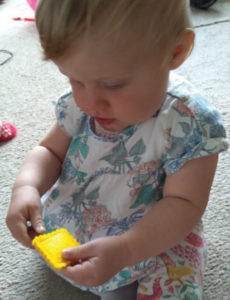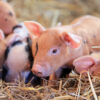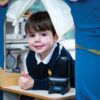 Once a baby is born they face a number of milestones, for example smiling for the first time and rolling over. We are told when their first tooth will appear and when they will have health visitor appointments but little is said about how their eyes develop and what their vision is like. At birth babies do not see as well as older children or adults. Their eyes and visual system aren’t fully developed, significant improvement occurs during the first few months of life.
Once a baby is born they face a number of milestones, for example smiling for the first time and rolling over. We are told when their first tooth will appear and when they will have health visitor appointments but little is said about how their eyes develop and what their vision is like. At birth babies do not see as well as older children or adults. Their eyes and visual system aren’t fully developed, significant improvement occurs during the first few months of life.
There are some milestones to watch out for in your child’s visual development. It is important to remember that not every child is the same and some may reach certain milestones at different ages. Babies born prematurely or with low birth weights are more likely to have vision problems. This is because their eyes miss out on the final stages of development towards the end of pregnancy.
Birth – 3 months:
Their vision is just starting to develop.
What to expect:
• Anything more than 20-30cm away from their face will just be a blur.
• Their world is black and white with shades of grey, as colour vision has not yet developed.
• They will only see large shapes, high contrast (big differences between light and dark) objects, bright lights and movement.
• They may only hold their gaze for a couple of seconds and will not be able to fixate with both eyes. It will be normal for their eyes to ‘wander’ at this age.
Things you can do:
• Develop that visual bond with them by trying to stay within 20-30cm when interacting with them – by
2 weeks they may start to recognise you. (Help them with this by not changing your appearance)
• Alternate sides when feeding to encourage equal visual development of both eyes.
• Use movements and bright contrasting colours (black, white and primary colours – reds, blues and yellows) in their room and with their toys to help stimulate their vision
3 – 6 months:
Depth and colour perception start to develop.
What to expect:
• They should start to watch and study their own hands as well as toys.
• They should begin to follow moving objects with their eyes and start to reach for things around them.
• Eye movement control and eye/body co-ordination skills steadily continue to improve – soon they can move their eyes without turning their head.
Things you can do:
• Help develop their eye tracking by talking to them as you walk around the room.
• Encourage visual development by frequently adding or changing and moving objects around their cot and room.
• Start to develop their visual memory by playing ‘peek-a-boo’ and similar games.
• Book their first eye examination at 6 months.
6 – 9 months:
What to expect:
• Their ability to hold attention increases.
• They should start to show interest in pictures, and recognise partially hidden objects.
Things you can do:
• Now is the time to start showing and reading simple books to them.
• Encourage the crawling phase – it helps develop better eye/hand co-ordination.
• Further develop their visual memory by playing ‘hide and seek’ with toys under a blanket then revealing them to them.
9-12 months:
What to expect:
• By 10 months of age, babies should be able to grasp objects with thumb and forefinger.
• They should be able to judge distances fairly well and throw things with some precision.
Things you can do:
• Play simple games like building blocks and rolling a ball back and forth. These help develop their grasp and also improves eye movement co-ordination and hand/eye co-ordination.
2 years onwards:
What to expect:
• Their eye/hand co-ordination and depth perception should be well-developed and their vision almost at adult levels.
Things you can do:
• We recommend that children should have their eyes examined annually.
NHS sight tests are FREE for children under 16
At all ages:
If you notice any of the following you should take your child to see a health professional as an evaluation is warranted as soon as possible.
• An opaque, white glow or white reflection in the pupil of an eye (the dark area in the centre of the eye.)
• A missing or altered ‘red eye’ reflection in photographs.
• Instances where the eyes do not appear to look in the same direction (a squint.)
• Watering, red,
sore or swollen eyes for no obvious reason.
• Drooping eyelids.
• A change in the colour of the iris (the coloured part of the eye) especially if only one area.
• Increasing sensitivity to light.
• You suspect that may be a deterioration in sight.
Please contact us if you have any concerns or questions. A PDF version of this is available upon request that can be added to your child’s
red book.
Barnard Associates is an established independent, Optometric providing clinical eye care, contact lenses and spectacle dispensing for over 30 years.
We recommend eye examinations for
all children from 6 months of age
or sooner if you have any concerns.
Our Optometrists specialise in
paediatric eye care ad have additional qualifications to provide visual assessments associated with dyslexia, dyspraxia, ADHD and learning difficulties – we welcome
any questions you may have
regarding your eye health.
Phone: 01273 77238
Email: reception@barnard-associates.co.uk











